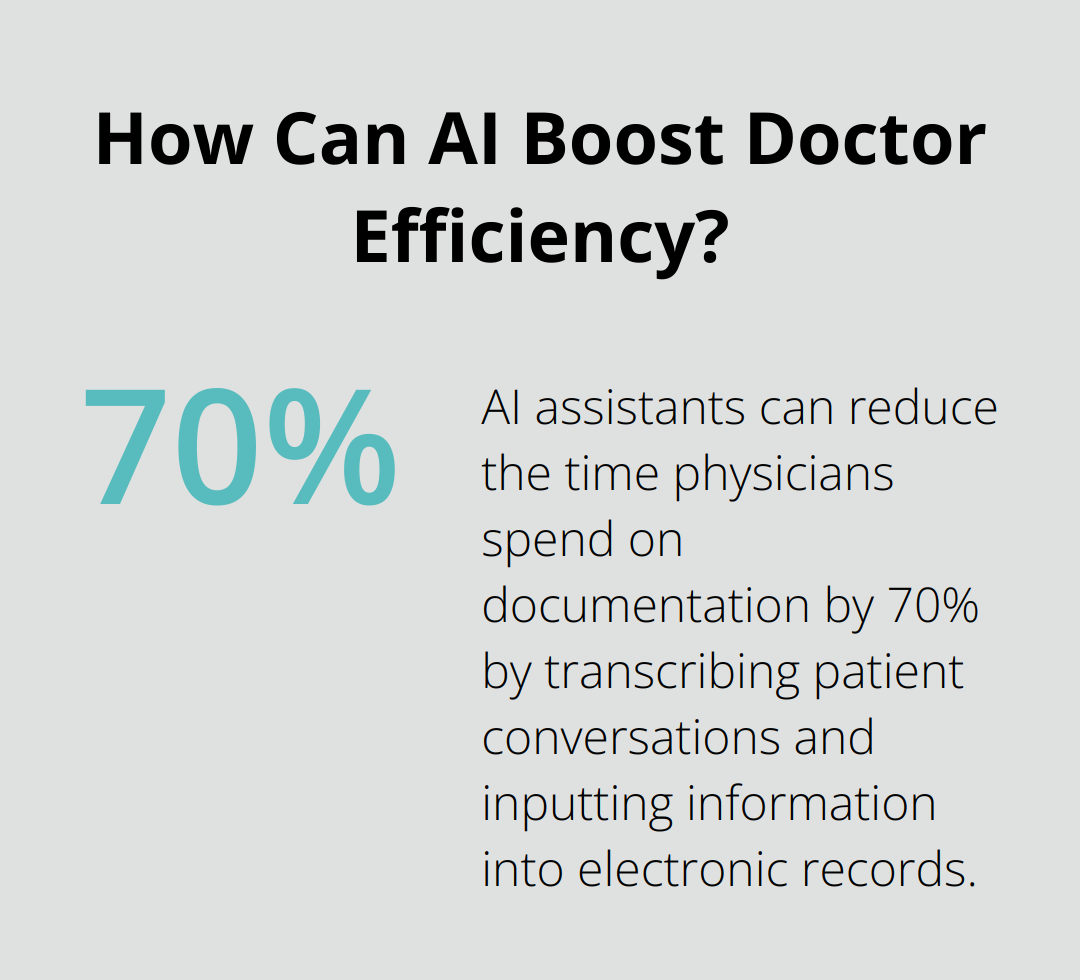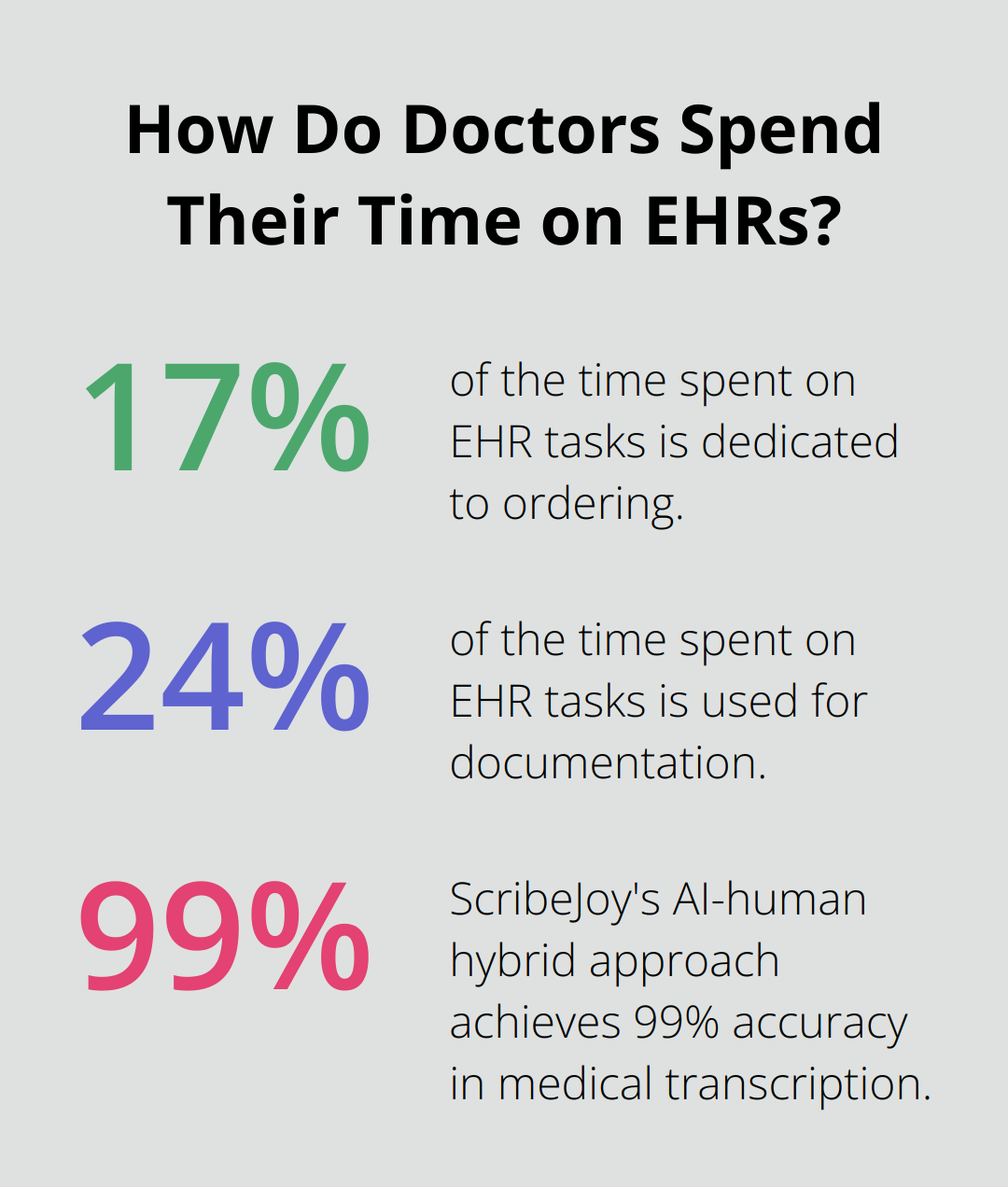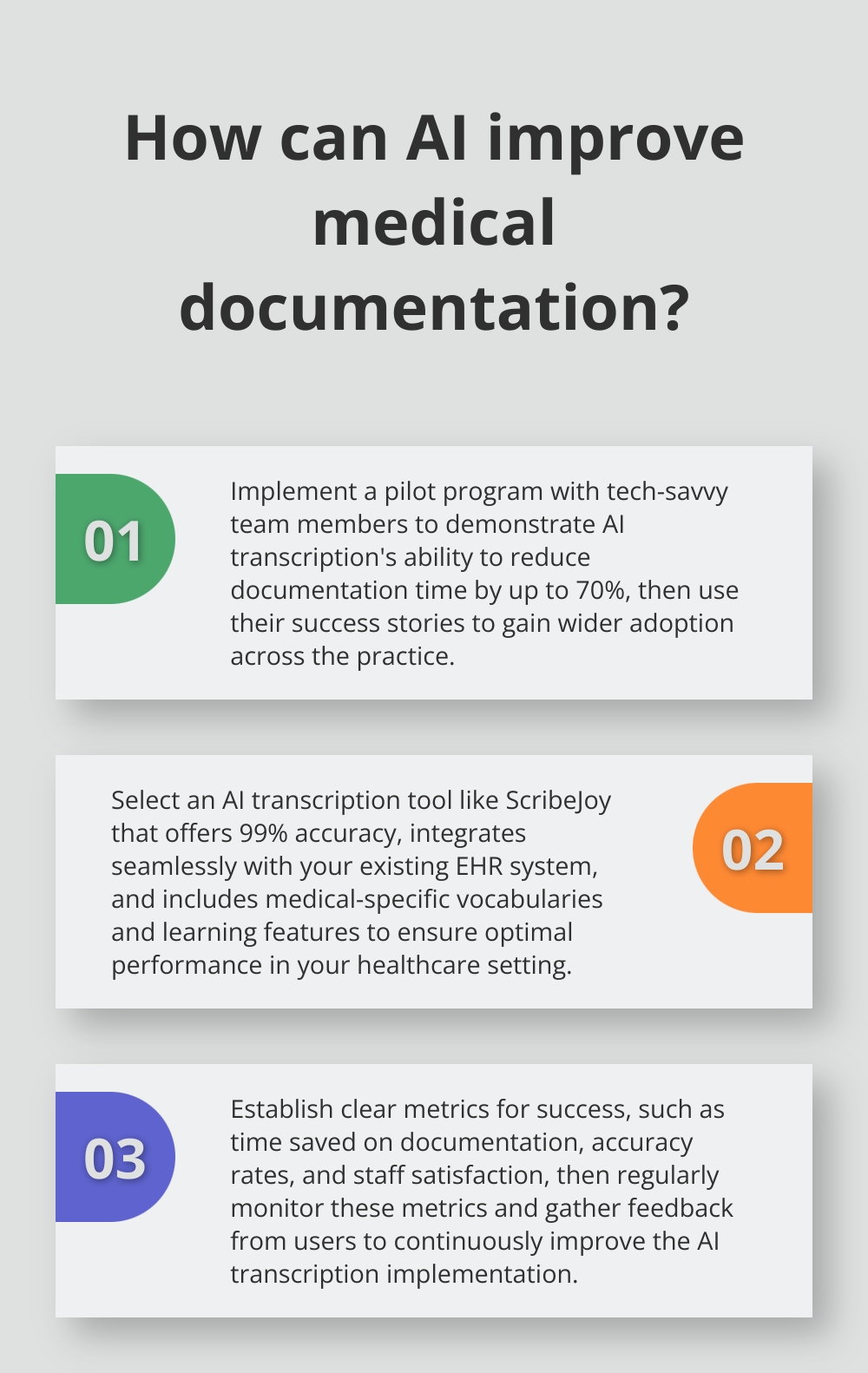AI transcription is shaking up healthcare documentation in a big way — cutting through the clutter, pumping up efficiency, and just outright transforming the game. Over at ScriberJoy, we’ve been watching this revolution in real time, and it’s something to behold.
This tech — all AI-powered and slick — is dialing down the admin drudgery, turbocharging the accuracy of records, and cranking up the speed of documentation. Stick around, and we’ll dive into how AI transcription is making waves in healthcare. Plus, we’ll give you the lowdown on how to get it rolling in your own practice. Buckle up.
How AI Transcription Boosts Healthcare Efficiency
AI transcription is flipping the script on healthcare efficiency. Let’s break down how this tech really shifts gears for medical practices.
Slashing Administrative Workload
Docs are drowning in paperwork – we’re talking two hours on admin for every one with a patient, according to the American Medical Association. Enter AI transcription… it’s like having a magic wand that automates all the dreary documentation.

AI assistants can reduce the time physicians spend on documentation by up to 70% by transcribing chats with patients and zapping info into electronic records. More face time with patients – less keyboard crunching.
Enhancing Record Accuracy
Precision in medical records is the name of the game. AI transcription isn’t just fast; it nails accuracy too. Epic Systems – big fish in electronic health records – uses AI to sniff out errors before sealing the deal on documentation.
Studies demonstrate improved accuracy and efficiency in clinical documentation, thanks to AI. This level of precision helps cut down the oopsies – affecting about one in twenty hospital patients – to near zilch.
Accelerating Documentation Turnaround
Speedy documentation is a cornerstone in healthcare. AI transcription trims down the time it takes to whip up medical records. Apollo Hospitals in India? They shrunk the discharge summary time from a half-hour marathon to under five minutes, courtesy of AI.
Fast docs mean:
- Zippier decision-making
- Seamless handoffs between caregivers
- Stellar patient outcomes
With AI transcription, healthcare pros tap into the latest patient info almost instantaneously – and the overall care quality? Through the roof.
Improving Clinical Workflow
AI transcription is like streamlining on steroids – automating soul-sucking tasks to let healthcare workers zero in on patient care.
Picture this: AI doohickeys can:
- Auto-fill electronic health records (EHRs)
- Turn messy notes into structured data gold
- Offer real-time translations during appointments
These tricks shave down the mental gymnastics required from healthcare pros, leaving them sharper all day, every day.
Enhancing Patient Engagement
AI transcription tools whip up patient-friendly summaries out of tangled medical notes. Think of these as cheat sheets for patients to grasp their health and treatment plans.
Microsoft’s Nuance DAX Express (yep, another AI marvel) churns out structured visit recaps straight from doc-patient chit-chats. This tech closes the loop between docs and patients, boosting engagement and satisfaction through the roof.
Next stop? Let’s dive into what makes AI-powered medical transcription software the heavyweight champ in transforming healthcare documentation.
What Makes AI Medical Transcription Software Tick?
So, we’ve got AI-powered medical transcription software shaking up healthcare documentation. It’s this nifty tech that takes spoken words and — poof — turns them into text using some serious fancy speech recognition and natural language processing. But wait, there’s more. It’s not just playing stenographer.

We’re talking smart systems here. They get medical lingo, know who’s speaking, and can pick out context like a champ. You say “heart murmur,” and the software’s not thinking it’s some secretive whisper… it knows.
Integration with Electronic Health Records (EHR)
Listen, the EHR system integration is where things really start to sizzle. This isn’t just about cranking out transcripts; it’s about seamlessly weaving that info right into patient records already in the system. It’s cutting down on those pesky data entry errors and shaving loads of time off the docs’ grunt work. Imagine slashing documentation time by up to 70%. Yeah, that’s what these AI helpers are aiming for by getting all that patient encounter info into EHRs.
Tailored for Medical Specialties
We all know healthcare’s no cookie-cutter gig, and AI transcription software’s hip to this scene. We’ve got customizable templates and vocabularies made-to-order for each specialty. An orthopedic doc and a shrink? They’re speaking different languages, and this software’s flexible enough to adjust on the fly.
These tweaks are essential for getting things right and working efficiently.
Real-time Feedback and Learning
Modern AI transcription is like having this coach that gives you real-time feedback — catching errors or wonky inconsistencies before they make it into the record books. Helps nip those mistakes in the bud right then and there.
Plus, these systems are like fine wine… they get better with age. The more a healthcare pro uses this tech, the sharper it gets at catching their drift, understanding speech quirks, and nailing down terminology. It’s like having a medical scribe that smartens up with each patient sit-down.
Security and Compliance
Data security? Not optional, folks. Top-drawer AI transcription tools (like ScribeJoy) bake HIPAA compliance right into their core. They’ve got encryption, rock-solid cloud storage, and ironclad access controls to keep patient info locked down tight.
AI-powered medical transcription software is staking a claim as the gold standard for slick and precise medical record-keeping. Fusing slick AI tech with healthcare-specific prowess, it squares up to the real-world challenges of healthcare documentation. As the scene evolves, it’s worth the deep dive to see how healthcare movers and shakers can get this game-changing tech into their daily practice.
How to Implement AI Transcription in Your Healthcare Practice
Assess Your Current Workflow
Let’s dive in, shall we? Implementing AI transcription in healthcare? It’s not just flip-a-switch stuff-strategic planning is your friend. First up, take a hard look at your documentation process. What’s bogging you down? Are docs drowning in a sea of notes after shifts? Medical coding crew buried under a backlog mountain? Well, hello, AI transcription, you’re up.

There’s this study-turns out docs spend 16 minutes per encounter on EHRs. That’s precious time devoured by chart reviews (33%), documentation (24%), ordering (17%)… you get the picture. Time better spent on, oh, I don’t know, patient care? Or maybe solving the next medical breakthrough. So, find those time-suckers and get ready to target your AI transcription efforts effectively.
Select the Right AI Transcription Tool
Heads up, they’re not all created equal. You need the crème de la crème of AI transcription tools. Something that can tackle medical jargon like a pro and gets your team’s vibe. Hunt down solutions with vocabularies and learning features that scream medical genius.
Consider ScribeJoy. This one’s got the AI-human tag team for a whopping 99% accuracy. But whatever you choose, make sure it slides right into your existing EHR system. No anvils for your IT folks, please.
Secure Team Buy-In
Here’s the deal: AI transcription hinges on your team’s buy-in. Launch a small pilot program with your tech-savvy stars. Get them onboard, and their stories of glory will spread like wildfire.
Training? Top priority. Don’t just toss them the keys and vanish. Put on some hands-on demos that showcase real-deal benefits. Show how AI can slash documentation time by 70%-and blow some minds in the process.
Monitor and Adjust
Implementing AI transcription-it’s the journey, not the destination. Start small, measure your steps, tweak as needed. Set some North Stars like time saved, accuracy, team happiness. Keep checking that compass.
Champion feedback. What’s your team saying? Their insights could be game-changers. Jump on concerns, keep the momentum pumping, and secure that long-lasting adoption.
Ensure Compliance and Security
Hold on tight-safety first. Healthcare data is not a plaything, and neither are compliance and security. Pick an AI solution that treats protection like royalty. Look for HIPAA compliance, top-notch encryption, secure clouds, tight access controls-the whole kit and caboodle.
Set up rock-solid protocols. Arm your team with the best data protection and patient privacy practices out there. Regular audits? Yes, make them your best friend to uphold those high security standards-AI transcription in healthcare doesn’t mean skimping on safety.
Final Thoughts
AI transcription in healthcare? It’s like swapping a horse for a Tesla-freeing up medical pros to actually focus on patient care. This tech jazzes up workflows, boosts record accuracy, and speeds up the whole docs game. But hold onto your stethoscopes, because the next wave is gonna bring tools that break down medical chats and squeeze out insights, making everything smooth like a fresh jar of Skippy.

Hop aboard the AI train now, and healthcare providers can ride at the front with efficiency and patient care that’s off the charts. ScribeJoy is stepping up with reliable, HIPAA-compliant transcription that’s as flexible as a yoga instructor. Those who click with AI transcription today are gonna find tomorrow’s hurdles looking pint-sized.
Why wouldn’t you want to swipe left on paperwork and get back to top-notch patient care? This one’s a no-brainer-cut the doc piles, boost efficiency (a no-brainer for streamlining workflows). Healthcare is jamming down the fast lane, so… time to hit the accelerator.

Leave a Reply
You must be logged in to post a comment.